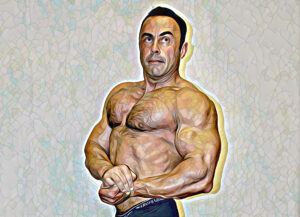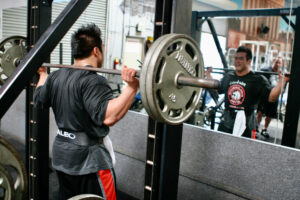Strength Sensei 101: Tempo

More insights into the training methods of Charles R. Poliquin
Having established guidelines for determining reps and sets, Charles R. Poliquin said the next step in program design is to decide on what contraction speed, or tempo, the reps of each exercise should be performed. This is a loading parameter often neglected in many strength training programs.
In the early years of strength coaching, there were spirited debates among strength coaches about what speed of movement was best for athletic performance. One school of training advocated high-velocity training, such as plyometrics, while others advocated slow training, including isometric and eccentric work. The Strength Sensei believed that both types of contraction speeds had their place in athletic fitness training. Here are 10 conclusions about this training variable the Strength Sensei discovered from his research and hands-on work with athletes:
- Strength development is velocity specific. Training at slow speeds is superior for developing strength at slow speeds but is not as effective for developing strength at high speeds. Although the Strength Sensei was not a fan of isokinetic training devices that precisely controlled the speed an exercise was performed, these devices provided insight into the importance of prescribing exercise tempos. An excellent review of research on velocity-specific training was published in 1993 in Sports Medicine. Concluded the authors (whom the Strength Sensei cited in several journal articles), “Resistance training at a specific speed will exhibit optimal gains at a similar testing speed with decreasing improvement as the testing speed deviates farther from the training speed.” [Behm, D., and Sale, D.G. Velocity Specificity of Resistance Training, Sports Medicine, July 1993, 15(6):374-88.]
- Muscles gain strength faster if trained at various speeds than if trained at the same speed. The Strength Sensei believed that variety is a key ingredient in making optimal progress and, for this reason, would vary his tempo prescriptions frequently.
- Training at high speeds with light weights does not produce significant increases in strength compared to training at slow speeds. In a paper that the Strength Sensei frequently cited, the authors concluded, “In high velocity contractions, the tension developed within the muscle is relatively small; thus, high-velocity training will not be very effective in stimulating muscle adaptation (hypertrophy). Therefore, the strength training programme designed for “speed” and “power” athletes should include fast movements to train the muscles.” [Sale D.G., MacDougall, D.G. Specificity in Strength Training: A Review for the Coach and Athlete. Canadian Journal of Applied Sports Science, 1981, 6:87-92.]
- Because the time available for muscles to contract in sports is often brief, it’s important to emphasize the early part of force development. In powerlifting, more force can be produced because the time allowed to produce force is longer, near isometric. However, in most sports, strength must be displayed rapidly for optimal performance.
- Although strength training at high speeds has a significant transfer to athletic movements, such training should be preceded by a base of slow-speed training. If performed against high forces, training at slow speeds is superior for developing maximal strength, which the Strength Sensei believed was important for beginners. This statement refers to training age, not chronological age – a 50-year-old could be considered a beginner in training age.
- For slow-speed work, the upper limit for time-under-tension should be 60 seconds. For example, if it takes 6 seconds to complete a single repetition in a squat, no more than 10 reps should be performed.
 The total time-under-tension for slow-speed training should not exceed 60 seconds. (Miloš Šarčev photo)
The total time-under-tension for slow-speed training should not exceed 60 seconds. (Miloš Šarčev photo)
- When the weight on the bar is increased, the athlete should still try to produce high-speed movements, even though the actual speed of movement decreases. Fred “Dr. Squat” Hatfield popularized this concept with his term “compensatory acceleration.” (Hatfield, F.C., Power: A Scientific Approach. 1989. 1st edition. Chicago: McGraw-Hill.)
- In designing strength programs for athletes, the general preparatory phase should focus on moderate to slow tempo movements. It follows that as the competitive season approaches, the speed of the movement of the exercises performed should increase.
- The potential to increase strength is greater at slow speeds than at high speeds. The Strength Sensei said that an athlete should therefore expect to see much faster rates of improvement in the back squat (relatively slow lift) than the power clean (relatively fast lift). [Coyle, E.F. and Feiring, D.C., Muscular Power Improvements: Specificity of Training Velocity. Medicine and Science in Sports and Exercise, 1980, 12(2):134.]
- As the level of an athlete’s qualification increases, the need for eccentric strength work is increased to continue accessing the higher threshold motor units. The Strength Sensei believed that the amount of eccentric work should increase as an athlete’s strength increases. Pierre Roy, a weightlifting coach whom the Strength Sensei considered a mentor, used eccentric training to improve the squat of weightlifter Jacques Demers. At a bodyweight of 165 pounds, Demers squatted 583 pounds (346 percent of bodyweight). After a period of eccentric training, he squatted 617 pounds (373 percent of bodyweight) and did a vertical jump of 35.9 inches.
It’s been said that in the field of strength training, some believe experience is a substitute for education, and others believe that education is a substitute for experience. Charles R. Poliquin achieved his high level of success by educating himself with academic research and then applying this knowledge to his athletes. (TSS)
